When it comes to action cameras, there's one name that stands out above all others: GoPro. Other challengers have entered the market, but for people keen to capture the moment in the best clarity, GoPro is still the top choice.
The newest line-up from GoPro was announced in the autumn of last year. To help customers understand the options available, GoPro have simplified the line-up with a colour coded range. So, which one is best; black, silver or white?
In its simplest format, the range identifies the black as the top end, the silver as the mid-range and the white as the entry level GoPro Hero 7. But what's really different about each model, and which is right for you? We're going to compare the range to help you make a more informed choice.
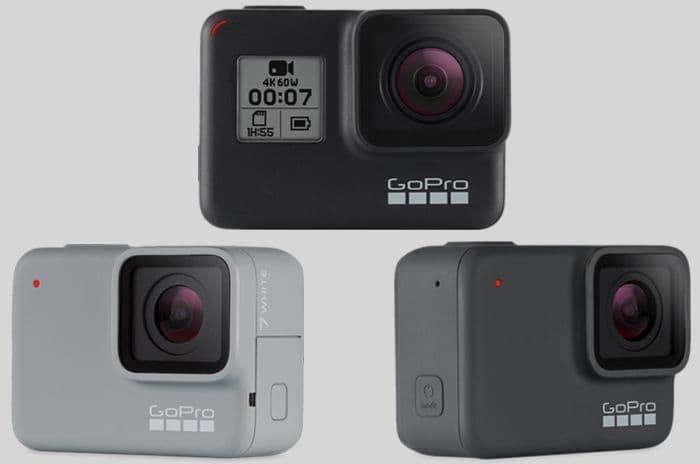
At a glance
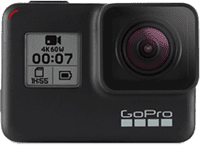 |
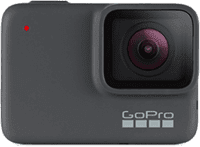 |
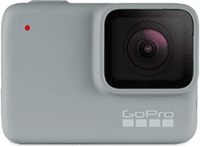 |
|
|---|---|---|---|
| GoPro 7 Black | GoPro 7 Silver | GoPro 7 White | |
| Price RRP | £379 | £279 | £159 |
| Resolution | Max 4K | Max 4K | Max 1080p |
| Max speed | 60fps at 4K / 240fps at 1080p | 30fps at 4K / 60fps at 1080p | 60fps at 1080p |
| Image size | 12MP | 10MP | 10MP |
| Image format | Jpeg and RAW | Jpeg | Jpeg |
| HDR photos? | Yes | No | No |
| Hypersmooth stabilisation? | Yes | No | No |
| Facebook Livestreaming? | Yes | No | No |
| Waterproof? | To 10m without case | To 10m without case | To 10m without case |
| Screen | 2" touchscreen | 2" touchscreen | 2" touchscreen |
| More info | More info | More info |
Design
All Hero 7 models follow the same design overall. They are smaller and lighter than previous models, at 6.2 x 4.4 x 3.2cm in size. This is truly tiny for an action cam, and the lightweight construction means it's very comfortable to have in a pocket or attached to a chest or head strap.
Looks-wise, they're all pretty similar. The shape is the same and the design, with the lens port on the top right corner, is uniform throughout the range. There is a slight variability in weight, with the Go Pro 7 Black being the heaviest, but overall there's not a lot of difference between the three.
All three also have a 2" touchscreen to the rear and are waterproof to 10m without any additional housing.
New features
There are some new features with the Go Pro 7 range, but not all of them are available on all models. Let's take a look at some of the standout new developments, and which cameras you can get them on.
HyperSmooth video stabilisation
Only available on Hero 7 Black
This feature is new to the 7 range and is actually quite an impressive addition. Go Pro say that it delivers 'gimbal-like video footage', but without the need for an actual gimbal.
If you don't know what a gimbal is, it's a pivoting camera stabiliser which turns shaky action footage into buttery smooth shots. With the Go Pro Hero 7 Black, you don't need an external gimbal at all, as it has internal three-axis stabilisation technology, which proactively corrects bumps, shakes and vibrations.
We found it made a huge difference to image quality when running or walking; see for yourself in our Go Pro Hero 7 review here.
SuperPhoto HDR Mode
Only available on Hero 7 Black
Although most of us use a Go Pro for action video, the newest model has been designed to be a capable device for still images too. The optional SuperPhoto mode chooses and applies one of four photographic enhancements: High dynamic range (HDR), multi-frame noise reduction, local tone mapping and no processing.
You don't need to worry if you don't understand what these are, as the clever Go Pro does it all automatically. You can opt for manual HDR only, which takes several shots in rapid succession and then stitches them into the perfect image. Otherwise, leave it on auto and it will do the hard work for you.
This mode has proven to be exceptionally good for landscape photography, when you want to capture a range of colours and textures in one image. It's not so good for action shots or capturing fast motion but puts the Go Pro up there as a solid option for a point and shoot camera.
TimeWarp Video
Only available on Hero 7 Black
If you've ever wanted to dabble in time-lapse video, this is a great inclusion in the new Go Pro. You simply tell the camera how long you want the video to be and it works it all out for you.
There are some limitations, for example the maximum recording time is five minutes to create a 10 second video. This means you won't be time-lapsing the entire sunset, but it does give you the option to make interesting videos of bike rides or runs.
With the in-built stabilisation and noise reduction, what you get is an incredibly stable, smooth recording of action over a longer period of time. The end result is truly impressive.
Live Streaming
Only available on Hero 7 Black
Who doesn't love a live stream these days? Having a connected Go Pro makes it easier than ever to get your precious content on to your social channel, and now you can even live stream as it happens, if you so desire.
The Hero 7 Black brings direct livestreaming to Facebook Live direct from the camera. It's a bit of a gimmick, and slightly disappointing that it's only Facebook (not YouTube or Instagram) that it's available on.
Vertical Shooting
Available on Hero 7 Black, Silver and White
One of the biggest drawbacks of the old Go Pros was that there was no automatic image correction if you decided to shoot in portrait mode. This meant you needed to manually edit each image to correct the orientation before you could share it with others.
Now, with the latest Go Pro, you can shoot how you want, and the image will present correctly. Available on all three models, this will make it a whole lot easier to snap and share.
Talking of sharing, the Go Pro app now allows direct sharing to Instagram, and with no editing necessary, you can get your photos up there for all to see moments after they're shot.
Photo Timer
Available on Hero 7 Black, Silver and White
Not exactly a ground breaking feature, but a new addition nonetheless, the camera timer has been built in to all three models of the Hero 7.
The built in timer lets you select from a three to 10 second delay. It's the first time Go Pro has put a timer on their cameras and promises to make it easier to nail awesome selfies and group shots.
Carried over features
Some things are common across the Go Pro range and have carried over from previous generations. However, the new Hero 7 does some of these better than previous models, and there are some differences between the three variants too.
Let's dive in and see what the new model brings to the features we know and love.
High resolution video
In video footage technical terminology, resolution is described in relation to the number of pixels the camera captures. You've probably heard of 1080p and perhaps even 4K, usually in relation to TVs and suchlike.
When we're talking about Go Pros, there's another part to this too. A second number refers to the number of frames shot per second. The higher this number, the smoother and more realistic the video will be.
In terms of the Hero 7 range, the Black is capable of up to 4K60 video. This means 4K resolution at 60 frames per second. For the Silver version, the maximum you'll get is 4K30, and with the White you're limited to 1440p60.
We say limited, but for the majority of us shooting in 1080p is more than enough for our day to day needs. 4K refers to footage which has literally four times the pixels of this, which takes up a massive amount of storage on your memory card and can be very demanding to process later on a computer.
For professional video editors, 4K is a dream. For the rest of us, 1080p60 is more than a capable standard. All three of the Go Pro Hero 7 variants can do this, so unless you're shooting for a career, it's not worth getting hung up on.
Removable battery
Annoyingly, only the Black has carried over the removable battery from the previous model. For anyone who shoots for extended periods of time, having a few spare batteries in your case can save missing some crucial moments.
However, like most smartphones today, the Hero 7 Silver and White no longer allow the battery to be removed. This means that, when it runs out of juice, you'll need to stop and recharge.
Photo quality
There is some variation in the quality of photos between the three devices. The Black will shoot stills in 12MP quality, while the White and Silver only go up to 10MP.
10 to 12MP is pretty standard across most digital cameras and good smartphone cameras today. The difference between 10 and 12 is really negligible, particularly if you're shooting primarily for photos to be viewed digitally. If you're planning to print them out in large format, a difference would be somewhat noticeable.
Protune
As with the Hero 6 Black, the Hero 7 Black comes with Protune capabilities. This allows you to adjust things like ISO limits, shutter speed, exposure and colour balance manually.
The White and Silver do not have this function. Everything is decided automatically by the camera itself, based on environmental conditions. For an amateur, access to Protune is probably overkill and something that you'll rarely use.
One other difference worth noting here is that only the Black comes with a GP1 image processing chip. This enhances colour and performance in low light and was also featured in the Hero 6 Black. It's not available in the Silver or White models.
Burst Mode and Slow-Mo
All three Go Pro Hero 7 models will give you the ability to take a burst shot. However, only the Black has a 30 frames per second capability; the Silver and White are limited to 15 frames per second.
Slow motion is available on all models too, but again the Black does it better. The Hero 7 Black offers up to eight times slow-mo, whereas the White and Silver only do two times.
GPS stamps
GPS tracking on the Go Pro lets you track your speed, altitude, distance and more, and is a must if you're keen to show off where you've been and how fast, far and high you went.
It's built into the Black and Silver but is not an option in the White.
Front screen
One of the most noticeable differences between the Black, Silver and White is that the Black has a screen on the front. This lets you keep an eye on things like battery life, settings and shooting mode, which can be useful if you're recording yourself.
Neither the Silver or White have a front LCD screen. This means that, if you've fixed it to the front of your snowboard, for example, you're essentially shooting blind. This could be incredibly frustrating if you nail a trick and only find out later than you ran out of battery five minutes before.
Black, Silver or White - which one is for you?
As much as it's nice to have the top of the range anything, the Go Pro Black comes with a lot of bells and whistles which, frankly, most of us are never going to use.
Having said that, it is the most advanced, pro grade Go Pro camera ever released. The HyperSmooth stabilisation is a game changer, eliminating the need for expensive gimbals to capture your action packed footage.
It's been designed for the professional user, but that doesn't mean you won't love it. Streaming to Facebook Live might be something you've always wanted to do and being able to shoot more advanced videos and stills definitely has its attractions.
Between the Silver and White, there's not an awful lot of difference to warrant the extra £120 investment. The key differences are:
- Ultra 4K footage: Available on Silver but not White
- Wide Dynamic Range images: Only on Silver
- GPS tracking: Again, not available on White
As you know, we don't believe in paying over the odds for something you don't really need. Unless you can see a situation in which you'll absolutely need 4K or can't live without a show-off GPS stamp for your video, it's a lot of money for not much extra stuff, as far as we can see.
Conclusion
It's impossible to say which Go Pro Hero 7 is best for you, but we can give you some guidance.
If you're shooting professionally or perhaps off on a once-in-a-lifetime adventure, the Black is the camera that won't let you down. Issues with charging are removed thanks to a changeable battery, and the videos and still you'll get back from this beast are truly second to none.
If what you want is a capable camera with a simple user experience, the results you'll get from either the White or the Silver won't disappoint. Those who primarily share their footage on social media and don't spend lots of time editing shots will be suitably impressed with what they can capture with these capable machines.
If you've never owned a Go Pro or are upgrading from an older model, particularly the Hero 3 or 4, you'll be blown away with the improvements in these latest cameras. Although you don't get HyperSmooth, you will get Go Pro's built in video stabilisation, which wasn't included in earlier models and really ups the professional finish to your videos.
Those who are convinced they don't need to drop close to £400 on the greatest Go Pro ever should think carefully when choosing between Silver and White. The big price difference between these two means it's really crucial to think about what you need from your camera.
With the spare change from a White, you could snag all those tools and accessories to make capturing incredible footage even easier!




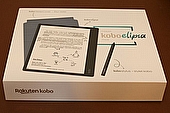




Comments